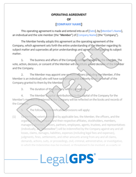Maintain Your Trademark Status: File a Statement of Use
If you've successfully filed a trademark application, congratulations—you've completed an important step in securing your brand. But to maintain your...
3 min read
LegalGPS : Oct. 14, 2024
To register your trademark, it must be "distinctive" rather than generic. This means that it can't simply describe the product or service. For example, you can't sell bananas and trademark the name "Bananas, Inc." If that were possible, one company would monopolize everyday words like "banana," making them unavailable for others to use.


Legal GPS Pro
Protect your business with our complete legal subscription service, designed by top startup attorneys.
Instead, your trademark should stand apart from common descriptions. A good example of a distinctive trademark is "Apple" for computers. The word "Apple" is not descriptive of computers, and using it this way makes it unique and memorable. On the other hand, a company named "Apple" selling apples would not be distinctive.
The U.S. Patent & Trademark Office (USPTO) uses five categories to determine trademark distinctiveness. We’ll start with the weakest category and work our way to the strongest.
Generic Names
Generic names cannot be trademarked because they simply refer to what the product is. For instance:
"Clock" for a wristwatch
"Tea" for a warm herbal drink
"Water" for bottled water
These terms describe everyday items and can't be monopolized by one company.
Descriptive Names
Descriptive marks provide some information about the product, such as its quality, function, or ingredients. These are also weak candidates for trademark protection. Examples include:
"Easy Bake Pie Crust" for a frozen pie crust
"Instant Dinner" for a microwave meal
These names directly convey what the product is or does, which makes them difficult to register as trademarks.
Master Intellectual Property for Business Success
Suggestive Names
Suggestive marks hint at qualities of the product without explicitly describing them. They require a bit of imagination from the consumer to understand the link between the mark and the product. Some examples are:
"Chicken of the Sea" for tuna
"Wite-Out" for corrective fluid
"Legal GPS" for legal navigation tools
Suggestive marks are often a close call for the USPTO, and some descriptive marks may try to pass as suggestive. For example:
SPEEDI BAKE for frozen dough: The USPTO found that it suggests a quality of the product—quick and easy baking—without explicitly stating it.
NOBURST for liquid antifreeze: The USPTO considered this suggestive because it hints at preventing bursts without directly describing the product's function.
Arbitrary Names
Arbitrary marks are dictionary words used in an unexpected way, unrelated to the product. This makes them stronger trademarks. Examples include:
"Apple" for computers
"Blackberry" for mobile phones
"GAP" for clothing
These words don’t have any inherent connection to the products they represent, making them highly distinctive.


Legal GPS Pro
Protect your business with our complete legal subscription service, designed by top startup attorneys.
Fanciful Names
Fanciful marks are the strongest type of trademarks. They are made-up words that did not exist before the brand was created. Examples include:
"Microsoft"
"Google" (Note: While the word "googol" represents a large number, "Google" as a brand name is distinctive.)
"Xerox"
Fanciful marks are inherently unique, making them excellent candidates for trademark protection.
A strong trademark should be distinctive from others in the market, regardless of pronunciation or translation. It should not create confusion for consumers or resemble existing trademarks.
Trademark Strength Through Actual Use
Trademark strength can also grow organically over time through actual use. Brands like McDonald's have become strong trademarks, even though "McDonald" is a common surname. The company has built such strong brand recognition that it is now synonymous with fast food. This demonstrates how consistent use and consumer recognition can significantly strengthen a trademark.
Action Step: When creating a trademark, aim for something that is either suggestive, arbitrary, or fanciful. Avoid generic or purely descriptive terms to increase the likelihood of registration.
Understanding the spectrum of trademark strength can help you position your brand for successful registration. Whether you opt for a suggestive, arbitrary, or fanciful mark, making sure it’s distinctive can save you time, money, and potential legal issues down the line.
The biggest question now is, "Do I need a business lawyer?” For most businesses and in most cases, you don't need a lawyer to start your business. Instead, many business owners rely on Legal GPS Pro to help with legal issues.
Legal GPS Pro is your All-In-One Legal Toolkit for Businesses. Developed by top startup attorneys, Pro gives you access to 100+ expertly crafted templates including operating agreements, NDAs, and service agreements, and an interactive platform. All designed to protect your company and set it up for lasting success.

Legal GPS Pro
Protect your business with our complete legal subscription service, designed by top startup attorneys.

100+ legal templates, guides, and expert advice to protect your business.
Trusted by 1000+ businesses

If you've successfully filed a trademark application, congratulations—you've completed an important step in securing your brand. But to maintain your...

Now that your trademark is registered, it's crucial to take steps to protect it. Trademark protection is an ongoing process that helps ensure your...

Registering your company name as a trademark can be a significant step in protecting your brand. But is it always necessary? Let’s break down what...